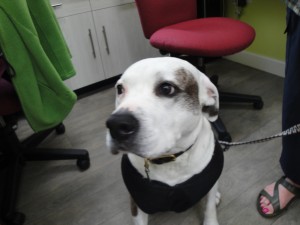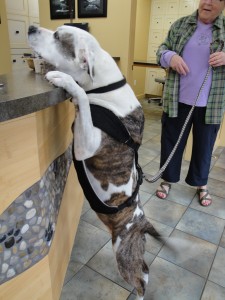Archive ∙ Back to Island Voices
April 2013
Darla, a sweet 7-year-old Pit Bull had been coming in to see us for Veterinary Neuronal Adjustment (VNA) (back treatments) on her arthritic spine every three months to maintain her mobility.
Last fall, we added a session of frequency-specific low level laser (FSLLL) following a VNA adjustment. She did so well following one treatment that her owner decided to do a full course of laser therapy. We began with two sessions the first day using laser frequencies for arthritis and musculoskeletal disorders.
Darla was moving much better after only a few treatments. Unfortunately, two weeks into her therapy, Darla ruptured her left cruciate ligament. Her knee joint had a drawer sign of 10 mm, which meant it was markedly unstable.
In medium- and large-sized dogs such as Darla, surgical stabilization is often recommended. Because of Darla’s positive response to the laser for her arthritis, her owner wanted to try that first. We recommended the following course of treatment:
- We initially restricted Darla’s activity to leash walks for bathroom breaks only.
- We exposed her to light frequencies aimed at stabilizing her stifle and continued with the ones she was already receiving for arthritis.
- We started Darla on a series of Cartrophen-Vet injections (weekly for 4 weeks and then monthly for 6 months).
Within a week, Darla was using her leg for walking. We suspect this rapid response and accelerated healing was due to the fact that she was already receiving laser therapy when the injury occurred. After one month, Darla was using her leg well. By 6 weeks, the tibial thrust and drawer (sliding) movement was much reduced. (see Therapy Options for Ruptured Cruciate Ligaments).
By 10 weeks, Darla’s drawer in her knee had reduced to less than 5 mm. She was using the leg without a limp and she was able to go on short, controlled walks.
By 14 weeks, Darla’s knee joint was stable. We continued monthly light therapy, coinciding with the cartrophen injections. Her owner slowly let Darla return to full activity. Darla’s stifle stabilized itself without surgical intervention.
What Darla’s owners had to say:
Approximately 3 years ago our rescued cream puff of an American Pit Bull Terrier was having a problem with her left rear hind quarter. Even though she is a stoic, she would yelp when getting off her chair. People in the neighbourhood noticed that her left thigh and hip were atrophying and that she had a slight limp. She was only 4 – 5 years old at that time. We had taken her to a vet who said it was hip dysplasia and offered little in the way of possible treatments. We met Andrea from the clinic and she suggested we bring her to be assessed by Dr. Jeff which we did.
An x-ray was taken and a bone spur on the lower vertebrae could be seen. Dr. Jeff suggested a course of treatments involving a spinal adjustment with gentle massage. The treatments were frequent at first but became further apart. We had strict instructions to control strenuous exercise, no longer demanding walks etc. These restrictions were gradually reduced, her muscle mass returned and the limp disappeared without surgery nor drugs.
About 18 months ago, Darla developed a problem with her cruciate ligament on her knee, again on the left side. It must be explained that Darla is very active and loves leaping, bouncing and twisting. Dr. Jeff presented us with the available options – surgery or a new approach laser light therapy – accompanied by injections of Cartrophen.
We began the treatments. Again there were restrictions involved, not easy, but we persevered. After several months the joint was healed and has remained solid. We are grateful to Dr. Jeff and staff for what they have done for our girl, especially being up to date on alternatives to surgical intervention that work.
— Colm & Judy
[disclosure: Clinical efficacy has not been documented in the literature. Although these results are anecdotal, we feel our laser has great potential in cruciate ligament injury.]




Leave a Reply